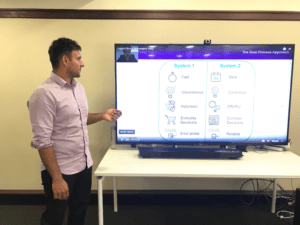 Increasing competencies with Diversity and Equity has been on the key goals this year at NYU Sydney. This led to a series of Diversity and Equity meetings and a training session conducted by Dr Tim Marsh (NYU Sydney Lecturer: Social Psychology) and Dr Suraj Samtani (NYU Sydney Lecturer: Multicultural Counselling). Both academic staff and administrative staff participated in this training and meetings this year to increase awareness and skills with diversity. We hope to lead by example and put our skills into practice every day. Here are some nerdy highlights:
Increasing competencies with Diversity and Equity has been on the key goals this year at NYU Sydney. This led to a series of Diversity and Equity meetings and a training session conducted by Dr Tim Marsh (NYU Sydney Lecturer: Social Psychology) and Dr Suraj Samtani (NYU Sydney Lecturer: Multicultural Counselling). Both academic staff and administrative staff participated in this training and meetings this year to increase awareness and skills with diversity. We hope to lead by example and put our skills into practice every day. Here are some nerdy highlights:
What do we know from psychology about biases?
The training session discussed how biases play a role in everyday interactions. The research from Social Psychology is that we have two distinct systems that influence biased thinking and behavior: System 1 (automatic, fast, not conscious) and System 2 (effortful, slow, conscious). We generally operate using System 1 which results in quick judgements and reactions that we are not necessarily aware of. It is only by being aware of our quick judgements that we can bring our behavior into consciousness and therefore, give it a different direction. Our System 1 typically reflects the biases inherent to the culture we live in and the media we consume, even if our System 2 would consciously reject them.
How can we know our own biases?
Instead of self-report measures (which assume conscious awareness), the staff were encouraged to find out their own biases using Harvard University’s Project Implicit. This involves a sorting task, where you must categorize both photos of people and either positive or negative adjectives. The website analyzes differences in reaction times in milliseconds and lets you know if you have biases and how strong they are. Staff were surprised to find the biases they held against those with different skin colors, sexual orientations and genders. Find out your own implicit biases here: https://implicit.harvard.edu/implicit/
How can we change our biases?
In our increasing ‘curated’ online world, our sources of knowledge are funneled to match our existing preferences. Finding out where are biases lie is the most important step. Making changes to diversify the shows we watch, the websites we read, and the people we interact with, gradually adjusts our preferences in System 1, changing even our most subtle and unintentional behaviors and reactions over time.
How can we change our approach in class and in our teaching?
The syllabus is one of the key areas where we can change what we do. The training highlighted steps like representing cross-cultural sources of information in the syllabus. The staff shared ideas such as marking using student numbers instead of names, including photos of professionals who come from diverse backgrounds, managing which groups of students we stand closer to while teaching, and balancing out the amount of time given to male vs. female students when answering questions in the classroom.
Our challenge to you
Find out your own biases using the Harvard implicit project test, check your syllabus for cross-cultural references and investigate your non-verbal reactions in the classroom.